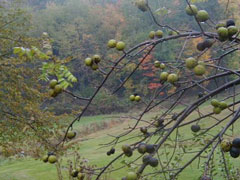


Home
Flowers &
Indoor Plants
Fruits & Nuts
Ornamentals
Vegetables
Special Topics
Resources
Glossary

|
Black Walnut Juglans hindsii (jug-lans hind-see-i) 







Click on thumbnails for larger image. |
 |
What about it? The common walnut is believed to have descended from trees native to Persia. The trees are very attractive, and can be seen in groves around old farms in New York. What is it used for? The meat of black walnuts has a very distinct flavor. In addition, the wood from a black walnut tree is used in the construction of fine furniture. Where does it grow? How do we grow it? Black walnuts grow best in deep, rich loam. They also require considerable moisture at the roots, and succeed best in bottomlands, near creeks and larger streams. What are its primary problems? The black walnut is attacked by insects, including the walnut husk maggot and nut weevil. The leaves of the walnut tree are enjoyed by the Regal moth caterpillar. Leaf spots and cankers can also affect walnut trees. The black walnut secretes a substance from its roots called "juglone." Juglone causes reactions in some plants that range from sensitivity to outright toxicity. For example, many garden plants such as tomato do not like to be planted near black walnut. How do we harvest and store it? Black walnuts are picked up by hand soon after the nuts fall from the tree. The husks are then removed as soon as possible. But be forewarned: walnut husks will stain your hands brown for days and even weeks. An easy method of husk removal is to place them in a driveway, where cars can crush the husks, but allow the nuts to remain undamaged. After the husks are removed and the fruit is dry, keep it in a dry, airy, vermin-proof shed in boxes or bins.
© Copyright, Department of Horticulture, Cornell University. |